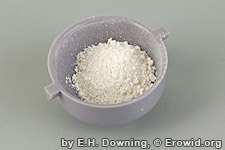Ibogaine
Basics
DESCRIPTION #
Ibogaine is a hallucinogenic chemical that can cause profound and long-lasting hallucinations. In its pure form, it is a white, bitter-tasting powder. It occurs naturally in a number of plants native to West Central Africa, including Tabernanthe iboga and Voacanga africana. Ibogaine-containing plants have a history of traditional use in West Africa in initiation ceremonies and religious rituals. Though there has been limited interest in ibogaine as a recreational psychoactive due in part to its long duration of action, Ibogaine has received attention in Europe and the U.S. since the 1960s as an anti-addiction therapy especially for the treatment of opiate addiction.
Dose #
When ingested in traditional religious ceremonies, ibogaine doses are highly variable. In TiHKAL, Shulgin and Shulgin describe typical doses of pure ibogaine HCl as "at or above 1000 milligrams", but also describe profound effects at 200 mg, orally. In the Manual for Ibogaine Therapy, Lotsof and Wachtel recommend 15-20 mg/kg for opiate addiction treatment. An ibogaine clinic reports administering a dose of 16-22 mg/kg. Note: Pure ibogaine dosages are much smaller than those of iboga powder, which is around 1% psychoactive alkaloids by mass.
Price #
Ibogaine is rarely found on the black market for recreational use.
Ibogaine is illegal to possess and sell in the United States (Schedule I) and in several other countries. It became a regulated substance in the U.S. in 1967.
The chemical name for ibogaine is 12-Methoxyibogamine (C20H26N2O). It is a naturally occurring indole alkaloid in the tryptamine family.
Pharmacology #
Ibogaine is slowly metabolized by the liver into noribogaine and other metabolites, some of which may be psychoactive. Ibogaine acts on numerous receptor systems, including the dopaminergic, serotonergic, nicotinic, GABA, and muscarinic systems. Some studies have found evidence that ibogaine may interrupt the mechanisms of opiate dependence.
Production #
Ibogaine is generally extracted from plant material, but may also be synthesized.
The T. iboga plant has been used ritually in Africa since at least the nineteenth century, perhaps much earlier. There are several contemporary iboga churches such as the Bwiti which use iboga as a sacrament and initiation tool. Ibogaine was first extracted from T. iboga in 1901. An ibogaine-containing extract was sold as an antidepressant called Lambarene in France beginning in 1939. During the 1960s ibogaine was briefly investigated as adjunct to psychedelic therapy. In the last few decades there has been continuing interest in Europe, North America, and Mexico in the use of ibogaine for addiction therapy.
Terminology / Slang #
Brand Names:
Lambarene.
The Substance:
Ibogaine.
The Experience:
No common terms known.
EFFECTS #
When taken in a strong dose, ibogaine often causes nausea and vomiting which may be followed by numbness of skin, mild auditory and dreamlike visual hallucinations lasting for 3-4 hours. This is frequently followed by an intense autobiographical inventory of the events and significance of one's life, lasting from 8-20 hours. Lingering physical effects such as difficulty sleeping may persist for an additional day or two.
Onset #
When taken orally, the effects of ibogaine usually begin within 45 minutes to three hours.
Duration #
The most intense effects of ibogaine may last 24 hours or more, during which time a user may be immobilized. After-effects may last an additional day or two.
Visual Effects #
Visuals Summary Needed.
PROBLEMS #
Several deaths have resulted directly from ibogaine ingestion. Users frequently experience extreme nausea. Depending on dose, users may be incapacitated and/or immobilized for many hours. High doses (beginning at 75-100 mg/kg) have been shown to have neurotoxic effects in rats and non-human primates, although therapeutic doses may not be neurotoxic.
Contraindications #
- Individuals with a history of heart ailments, high blood pressure, aneurysm or stroke, glaucoma, hepatic (liver) or renal (kidney) disorders, or hypoglycemia may be at higher risk.
- Do not operate heavy machinery. Do not drive.
- Due to its strong effects, Ibogaine should generally not be taken without a sober sitter present.
- Individuals should consider carefully before taking Ibogaine in situations where they are solely responsible for themself or anyone else.
- Individuals in the midst of emotional or psychological upheaval, or with a history of psychological illness, should use extreme caution in taking ibogaine or any other powerful psychedelic.
Addiction Potential #
Ibogaine is not believed to be physically addicting nor likely to cause psychological dependence. Withdrawal effects following discontinuation have not been reported.
Long Term Health Problems #
Long Term Health Problems Summary Needed.
Risk of Death #
There are several known fatalities due to ibogaine use. Some deaths have occurred in clinical or quasi-clinical environments. A 40-year-old woman died of heart failure after being administered 8 mg/kg in a psychotherapy session. In 2006, a 38-year-old man died of pulmonary thrombosis during ibogaine addiction treatment at a clinic in Tijuana, Mexico. Traditional iboga use is reported by some West Africans to be occassionally fatal, and there is at least one documented case of a fatality following ingestion of iboga root bark.
CAUTION & DISCLAIMER #
Erowid Basics pages are summaries of data gathered from site visitors, government documents, books, websites, and other resources. We do our best to keep this information correct and up-to-date, but the field is complex and constantly changing. Information should always be verified through multiple sources.


